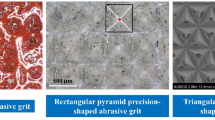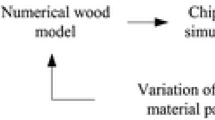Abstract
During the primary transformation in wood industry, logs are faced with conical rough milling cutters commonly named slabber or canter heads. Chips produced consist of raw materials for pulp paper and particleboard industries. The process efficiency of these industries partly comes from particle size distribution. However, chips formation is greatly dependent on milling conditions and material variability. Thus, this study aims at better understanding and predicting chips production in wood milling. The different mechanisms of their formation were studied through orthogonal cutting experiments at high cutting speed for beech and Douglas fir. Under these conditions, ejection of free water inside wood can be observed during fragmentation, particularly on beech. As previously seen in quasi-static experiments, chip thickness is proportional to the nominal cut thickness. Moreover, the grain orientation has a great influence on the cutting mechanisms, so as the nominal cut and the growth ring widths. This chip fragmentation study finally allows the improvement of the cutting conditions in rough milling. In order to optimize machine design as well as cutting geometry, a geometrical model of a generic slabber head was developed. This model allows the study of the effective cutting kinematics, the log-cutting edges interactions and the effective wood grain direction during cutting. This paper describes the great influence of the carriage position on cutting conditions. The results obtained here can be directly used by milling machine manufacturers.















Similar content being viewed by others
References
ASTM (1994) Standard test methods for small clear specimens of timber
Bodig J, Jayne BA (1982) Mechanics of wood and wood composites. Van Nostrand Reinhold, New York
Buchanan JG, Duchnicki TS (1963) Some experiments in low-speed chipping. Pulp Pap Mag Can 5:T235–T245
Chardin A (1958) Application of the dynamometric pendulum to research on the sawing of wood (in French). Bois et Forts des Tropiques 58:49–61
Denaud L, Bleron L, Eyma F, Marchal R (2012) Wood peeling process monitoring: a comparison of signal processing methods to estimate veneer average lathe check frequency. Eur J Wood Prod 70:253–261
Eyma F, Mausoone P, Larricq P, Marchal R (2005) Utilization of a dynamometric pendulum to estimate cutting forces involved during routing. Comparison with actual calculated values. Ann For Sci 62:441–447
Felber G, Lackner R (2005) Optimization of the production process of sawmill chips for the pulp and paper industry. In: Proceeding IWMS, vol 17, pp 225–240
Fromentin G, Poulachon G (2010a) Geometrical analysis of thread milling-part 1: evaluation of tool angles. Int J Adv Manuf Technol 49:73–80
Fromentin G, Poulachon G (2010b) Geometrical analysis of thread milling-part 2: calculation of uncut chip thickness. Int J Adv Manuf Technol 49:81–87
Goli G, Fioravanti M, Marchal R, Uzielli L, Busoni S (2010) Up-milling and down-milling wood with different grain orientations—the cutting forces behaviour. Eur J Wood Prod 68:385–395
Hellström L (2008a) Fracture processes in wood chipping. Master’s thesis, Mid Sweden University, Department of Natural Sciences, Engineering and Mathematics
Hellström LM (2008b) A method for experimental investigation of the wood chipping process. Nord Pulp Pap Res J 23:339–342
Hellström L (2010) On the wood chipping process—a study on basic mechanisms in order to optimize chip properties for pulping. PhD thesis, Mid Sweden University, Department of Natural Sciences, Engineering and Mathematics
Hellström LM, Gradin PA, Gulliksson M, Carlberg T (2011) A laboratory wood chipper for chipping under realistic conditions. Exp Mech 51:1309–1316
Hernandez RE, Boulanger J (1997) Effect of the rotation speed on the size distribution of black spruce pulp chips produced by a chipper-canter. For Prod J 47:43–49
Hernandez RE, Quirion B (1993) Effect of a chippercanter knife clamp on the quality of chips produced from black spruce. For Prod J 43:8–14
ISO (1982) 3002-1, Basic quantities in cutting and grinding. Part 1: geometry of the active part of cutting tools. General terms, reference systems, tool and working angles, chip breakers. ISO
ISO (1984) 3002-3, Basic quantities in cutting and grinding. Part 3: geometric and kinematic quantities in cutting. ISO
Kaymakci M, Kilic Z, Altintas Y (2012) Unified cutting force model for turning, boring, drilling and milling operations. Int J Mach Tools Manuf 5455:34–45
Kivimaa E (1950) Cutting force in wood-working. PhD thesis, Finland’s Institute of Technology
Laganiéere B (2004) Effect of canter head rotation speed, log feed speed and vertical position of logs on lumber surface and chip quality. Forintek Canada Corp, Quebec
Laganiére B (2006) Effect of knife velocity, knife bite and number of knives on lumber surface and chip quality in chipper-canter using bent knifes and disposable knifes (Phase III). Tech. rep, Forintek Canada Corp
Lusth H, Gradin PA, Hellström LM (2012) The dependency of energy consumption on cutting angles in the canter chipping process. Nordi Pulp Pap Res J 27:886–889
Mckenzie W, Ko P, Cvitkovic R, Ringler M (2001) Towards a model predicting cutting forces and surface quality in routing layered boards. Wood Sci Technol 35:563–569
McKenzie WM (1960) Fundamental analysis of the wood cutting process. PhD thesis, University of Michigan
Merchant ME (1945) Mechanics of the metal cutting process. I. Orthogonal cutting and a type 2 chip. J Appl Phys 16:267–275
Palubicki B, Marchal R, Butaud J, Denaud L, Bleron L, Collet R, Kowaluk G (2010) A method of lathe checks measurement: SMOF device and its software. Eur J Wood Prod 68:151–159
Thibaut B, Beauchêne J (2004) Links between wood machining phenomena and wood mechanical properties: the case of 0/90 orthogonal cutting of green wood. In: Proceedings of the 2nd International Symposium on Wood Machining, pp 149–160
Twaddle A (1997) The influence of species, chip length, and ring orientation on chip thickness. Tappi J 80:123–131
Uhmeier A (1995) Some fundamental aspects of wood chipping. Tappi 78:79–86
Uhmeier A, Persson K (1997) Numerical analysis of wood chipping. Holzforschung 51:83–90
Acknowledgments
This work was carried out in LaBoMaP at Arts et Metiers ParisTech Cluny. We acknowledge LBL-BRENT-CD company for their technical support, Mathieu Martin, LE2I lecturer, for his technical support in high-speed motions, LaBoMaP technicians, Philippe Lorong and Morgane Pfeiffer-Laplaud for their availability and advice.
Author information
Authors and Affiliations
Corresponding author
Rights and permissions
About this article
Cite this article
Pfeiffer, R., Collet, R., Denaud, L.E. et al. Analysis of chip formation mechanisms and modelling of slabber process. Wood Sci Technol 49, 41–58 (2015). https://doi.org/10.1007/s00226-014-0680-x
Received:
Published:
Issue Date:
DOI: https://doi.org/10.1007/s00226-014-0680-x




